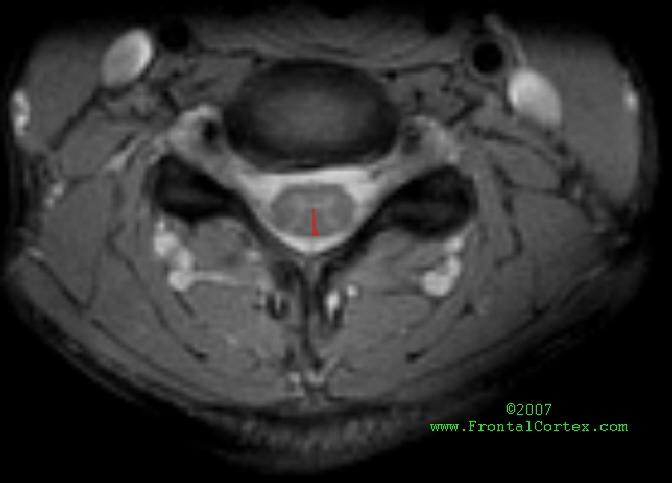Spinal Cord Anatomy 01
Topic: Anatomy
Created on Wednesday, May 2 2007 by jdmiles
Last modified on Wednesday, May 2 2007.
The T2 MRI above shows healthy spinal cord at the C6 level.
Which of the following statements is most accurate about the area highlighted in red?
This question was created on May 02, 2007 by jdmiles.
This question was last modified on May 02, 2007.
ANSWERS AND EXPLANATIONS
A) these neurons will synapse in the medulla
This answer is correct.
The fiber tract highlighted in red is the left fasciculus gracilis. This carries sensations of light touch, vibration, and proprioception from the more inferior portions of the body, such as the lower extremities. The cell bodies for these neurons are in the ipsilateral dorsal root ganglion. They ascend ipsilaterally until they reach the nucleus gracilis in the medulla, where they will synapse onto the second-order neurons. (
See References)
|
 |  |  | 
|  |  |
| Please log in if you want to rate questions. |
B) these are fibers that carry sensations of vibration and temperature from the right side of the body
This answer is incorrect.
The fiber tract highlighted in red is the left fasciculus gracilis. This carries sensations of light touch, vibration, and proprioception from the more inferior portions of the body, such as the lower extremities. The cell bodies for these neurons are in the ipsilateral dorsal root ganglion. They ascend ipsilaterally until they reach the nucleus gracilis in the medulla, where they will synapse onto the second-order neurons. Temperature is carried by fibers of the anterolateral system. (
See References)
|
 |  |  | 
|  |  |
| Please log in if you want to rate questions. |
C) these are fibers that carry sensations of light touch, vibration, and proprioception from the right side of the body
This answer is incorrect.
The fiber tract highlighted in red is the
left fasciculus gracilis. This carries sensations of light touch, vibration, and proprioception from the more inferior portions of the body, such as the lower extremities. The cell bodies for these neurons are in the ipsilateral dorsal root ganglion. They ascend ipsilaterally until they reach the nucleus gracilis in the medulla, where they will synapse onto the second-order neurons. Sensations of light touch, vibration, and proprioception from the right side of the body are carried by the right fasciluls gracilis and cuneatus. (
See References)
|
 |  |  | 
|  |  |
| Please log in if you want to rate questions. |
D) the cell bodies of these neurons are in the contralateral dorsal root ganglion
This answer is incorrect.
The fiber tract highlighted in red is the left fasciculus gracilis. This carries sensations of light touch, vibration, and proprioception from the more inferior portions of the body, such as the lower extremities. The cell bodies for these neurons are in the
ipsilateral dorsal root ganglion. They ascend ipsilaterally until they reach the nucleus gracilis in the medulla, where they will synapse onto the second-order neurons. (
See References)
|
 |  |  | 
|  |  |
| Please log in if you want to rate questions. |
E) these are fibers that carry sensations of vibration and temperature from the left side of the body
This answer is incorrect.
The fiber tract highlighted in red is the left fasciculus gracilis. This carries sensations of light touch, vibration, and proprioception from the more inferior portions of the body, such as the lower extremities. The cell bodies for these neurons are in the ipsilateral dorsal root ganglion. They ascend ipsilaterally until they reach the nucleus gracilis in the medulla, where they will synapse onto the second-order neurons. Temperature is carried by fibers of the anterolateral system. (
See References)
|
 |  |  | 
|  |  |
| Please log in if you want to rate questions. |
References:
| 1. Moore, K.L. (1992). Clinical Oriented Anatomy, 3rd Edition. Williams & Wilkins, Baltimore. | |
| 2. Walter J. Hendelman. . Philadelphia : W.B. Saunders, c1994. (ISBN:0721654282) | Advertising:
|
| 3. Nolte, J. (1993). The Human Brain: An Introduction to Its Functional Anatomy. Mosby, St. Louis. | |
| 4. James D. Fix. . Rockville, Md. : Aspen Publishers, 1987. (ISBN:0871898586) | Advertising:
|
| 5. Duane E. Haines. Neuroanatomy: an atlas of structures, sections, and systems. Philadelphia : Lippincott Williams & Wilkins, c2000. (ISBN:0683306499) | Advertising:
|
| 6. Stephen J. DeArmond, Madeline M. Fusco, Maynard M. Dewey. Structure of the human brain: a photographic atlas. New York : Oxford University Press, 1989. (ISBN:019504357x) | Advertising:
|
| 7. Stephen Goldberg. . Miami : MedMaster, c2000. (ISBN:0940780461) | Advertising:
|
| 8. David L. Felten, Ralph F., Md. Jozefowicz, Frank H., Md. Netter, . . ICON Learning Systems (ISBN:1929007167) | Advertising:
|
| 9. James Fix. High-Yield Neuroanatomy (High-Yield). Lippincott Williams & Wilkins (ISBN:0683307215) | Advertising:
|
| 10. Duane E., Ph.D. Haines, . Neuroanatomy: An Atlas of Structures, Sections, and Systems. Lippincott Williams & Wilkins (ISBN:0781746779) | Advertising:
|
| 11. by Frank H. Netter; Arthur F. Dalley II, consulting editor. . East Hanover, N.J. : Novartis, c1997. (ISBN:0914168819) | |
|
 |  |  | 
|  |  |
| Please log in if you want to rate questions. |
FrontalCortex.com -- Neurology Review Questions -- Neurology Boards -- Board Review -- Residency Inservice Training Exam -- RITE Exam Review
anatomy
Spinal Cord Anatomy 01
Question ID: 050207180
Question written by J. Douglas Miles, (C) 2006-2009, all rights reserved.
Created: 05/02/2007
Modified: 05/02/2007
Estimated Permutations: 25200




































